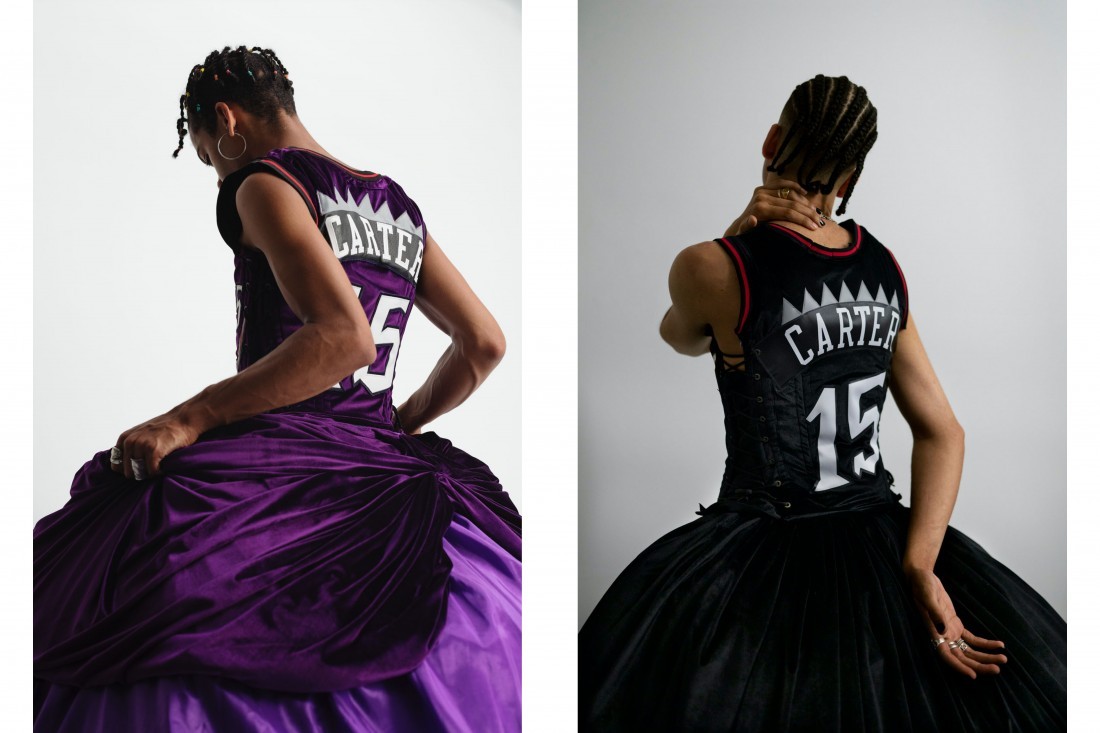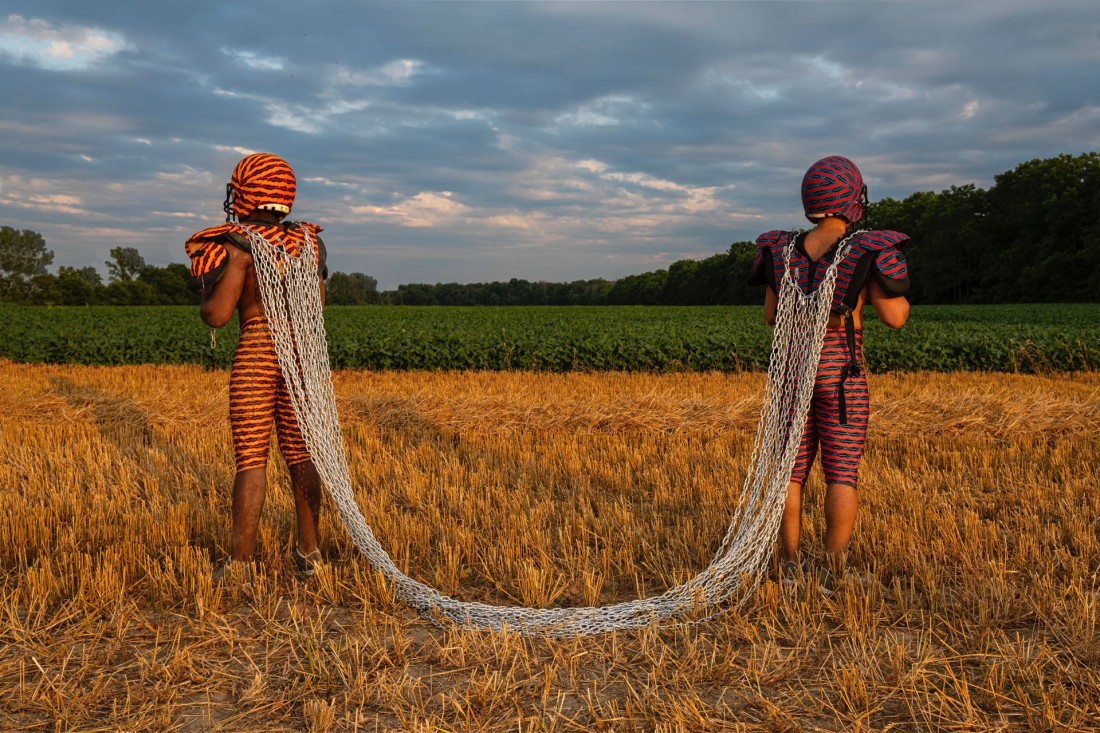Esmaa Mohamoud
Game Changer
For Esmaa Mohamoud, growing up as the only girl between two older brothers and two younger ones, an engagement with sports was inevitable. A self-described tomboy, she played sports like a boy, wore a jersey, was a Raptors fan who admired Vince Carter and wanted some of his magic for her own. That is, until her mother insisted on dresses and Esmaa, even then squaring off on issues of gender and sports, stepped out in a dress, with a jersey over top.
“One of the Boys,” a series she produced in 2017–19, addresses a range of issues, from Black men feeling the need to assert hyper-masculinity and eschewing any sign of vulnerability or fragility, to the underrepresentation of women in sports, to set definitions of gender and the searing associations she draws between athleticism and what she refers to as “neo-slavery.” Basketball is the sport she knows best, but her work also engages football. In both she identifies unnerving parallels between these sports with largely Black athletes playing together on a team, linked or tied, as it were, to the necessity to be one of the gang. Directly, and without embellishment or lengthy verbal buttressing, she says, “I saw a lot of parallels between contemporary forms of slavery, which I believe athleticism in the sport world is for Black people today, and historical forms of slavery.”
There’s an intended ambiguity or maybe a bifurcation in Esmaa Mohamoud’s work. The wealth and glamour of being a sports star are weighed against the physical damage suffered and the indenture that comes with the job. There is an anomalous but not parodic apprehension in seeing a tall, well-muscled basketball player, broad-shouldered and wasp-waisted, in a ballgown of satin and velvet, with hooped and crinolined skirts. The sense of frustrated or blocked achievement, of opportunities to participate and play and then the impediments thrown in the path, is evident throughout Mohamoud’s work. You see it in Heavy Heavy (Hoop Dreams), 2016–17, where 60 solid but deflated cast concrete basketballs present as far from their intended function as does the piece I Am, 2015, an oversized basketball hoop made of fine chains, invisibly suspended from the ceiling at an inoperable height, the chains that make up the net trailing and pooling on the floor, beautiful but without utility.

Left: Esmaa Mohamoud, One of the Boys (Double Dutch 1), 2018, inkjet photo. Right: One of the Boys (Black), 2019, inkjet photo. All photos courtesy the artist and Georgia Scherman Projects.
It’s in the reading provoked by the gorgeous rattan work A Seat Above the Table (Warren Moon), 2018, a tribute to the only Black quarterback to be inducted into the NFL Hall of Fame. For the artist it is another of many deliberate lacunae in white society’s record—gaps in recognition and the erasure of memory, accomplishments overlooked and intentionally minimized or ignored. A Seat Above the Table is a throne, elegant, graceful, but a seat that can’t be reached, and neither could it support the weight of the victor for whom it was made. In the history of art antecedents it put me in mind of an equally improbable and fragile artwork, Throne from 2006, which is a wooden kitchen chair supported on narrow stilts as thin as the antennae of some exotic insect. It’s by the Kenyan-American artist Wangechi Mutu. Esmaa Mohamoud readily recognizes Mutu as an inspirational source. Neither of the two elevated chairs could represent anything more clearly than what is, alas, the unattainable. But both artists aspire to, and, through their work, will ultimately make the elevated seat an appropriately earned and functional place.
Esmaa Mohamoud talked at length, in the interview that follows, about a work titled Why See the World When You Got the Beach?, 2018. She said, “My dad’s mouth told a story.” She could as easily have said her dad’s mouth told the story because that single piece could be a metonymy for an entire tragic history. The question “Why see the world when you have a beach?” stands in for “Why want more? Why not be content settling for less, for little? Who are you to aspire to anything at all?” The artist tells the story of her father’s migration to Canada, prepared for his new life with a PhD in economics and told, on arrival, that it would be years before he could qualify. With a family to support he took other work, was a courier, and was never deemed able for the career he should have had. Years of coffee and cigarettes and lack of dental care left him with what she describes as “terrible teeth,” but they were his, nonetheless, and for her they did tell a story. So she had them cast in gold. The resulting art piece is layered with multiple meanings. Slaves had been identified by their teeth, for one. Football players wear mouthguards—grills—for protection, for another. The buy-off, the trade-off, is that, inserted, they become silencers, leaving the players with no voice for complaint. And Esmaa Mohamoud has a gold grill, too, because, she said, it was expected that as a Black person she’d aspire to the visible glamour and success it represented.
It doesn’t function to silence her. Instead, her strong, persistent work gives her a voice, and the little Black girl who grew up in northern Ontario where she felt she was never seen, except as other, is now unavoidably and rightly very visible.
This interview was conducted with the artist on August 18, 2020.
BORDER CROSSINGS: What was it in the 10th grade that made you decide you wanted to be an artist?
ESMAA MOHAMOUD: I had been in art classes my entire childhood because my parents realized that I had a liking for art. In high school you have to take only one course of art in order to graduate and I was taking it every year. In the 10th grade, it just sunk in. I was 16 and it was like, “I think this is what I’m supposed to be doing.”
Tell me the story of your discovery of the jersey and the dress. Your mother played a role, didn’t she?
I have four brothers and am a tomboy through and through. I always wore jerseys, and one day I came downstairs to play outside and my mom said, “If you want to play outside, you’ve got to put on a dress.” I was like, “What’s going on? How dare she tell me what I can and can’t wear?” I decided I was going to show her, so I put on a dress, but I put the jersey over top. The top part was a jersey and I had this tutu-esque dress popping out from the bottom. When I came down she said, “You’ve got to realize that you’re not one of the boys.” And that phrase, “you’re not one of the boys,” stuck with me. So the piece evolved at this one period of my life where I was trying to understand the ways in which I had consumed my own gender and the ways in which I was supposed to perform my gender. It just exploded at that moment and I was like, “I got to get this piece out.”
Was your mother trying to put you in a gendered place that you hadn’t recognized?
I understand how my parents think. They think man is man and woman is woman, but even at a young age I understood that I was a girl but I also wanted to perform my gender in a masculine way. I didn’t want anybody to tell me that I couldn’t do it that way. It was funny because my mother had discarded my jersey and it was traumatic for me because I had saved up all my money to buy it. Ironically, that’s why I was wearing it every day. My mom and I have had many conversations after she saw the piece and she was like, “I’m so sorry, I didn’t realize what I had done.” And I’m like, “Well, if anything you made a good work out of it. I can’t be too angry.”
Had you already become a sports fan?
I am the middle child among four brothers, so becoming a sports fan was a way for me to bond with them. They didn’t care about the girly things I cared about, like nail polish and hair. But they loved sports and from a young age I loved them, too. My dad put us all in sports because he saw it as a discipline. I was very athletic and at a very young age I was a Raptors fan. I thought I wanted to be Vince Carter when I was a kid. He would do things on the court that didn’t seem possible. I think it was his essence and his almost magical aspect that made me want to be like him when I grew up.

Esmaa Mohamoud, “Deeper the Wounded, Deeper the Roots II”, 2019, inkjet photo.
How did sports become a way for you to investigate this troubled connection between the exploitation of the Black body and the industry of sport itself? When did you realize there was a politic and critique built into your love of sports?
I guess it happened by chance during my master’s program. I realized that speaking about race made a lot of people uncomfortable. I was thinking about things that people find easygoing and I realized that nobody feels awkward talking about sports. So I thought if I made work about sports and about race, then people would be forced to talk about race. It was my sneaky trick.
Were you also interested in using sports as a way of investigating gender applications and the way roles are assigned? Because in “One of the Boys” (2017–19), one of the boys is a girl, right?
Yes, some of the figures are women. I felt there were lots of conversations that needed to be had around the representation of women in sports, which is part of what “One of the Boys” was. The reason I included women was not just to have them represented but to acknowledge the fact that most people can’t name five players in the WNBA and this is a problem. Women play the same sport, but they don’t get the same amount of recognition as men playing in the NBA. There’s a whole field of things that I could tackle with sports. I focused on Black masculinity in sports because that’s what I was most invested in, especially growing up with Black men around me my entire life. I was really invested in that but there are so many more topics that could be talked about through the vernacular of athleticism.
…to continue reading the interview with Esmaa Mohamoud, order a copy of Issue #155 here, or Subscribe today.

